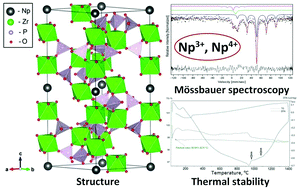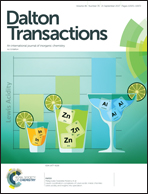Synthesis and investigation of neptunium zirconium phosphate, a member of the NZP family: crystal structure, thermal behaviour and Mössbauer spectroscopy studies
Abstract
A new double neptunium zirconium phosphate of the type MxZr2(PO4)3 (M = Np), crystallizing in the structure type NaZr2(PO4)3 (NZP, NASICON), was synthesized by solid state reactions at high temperatures and characterized by X-ray diffraction, infrared spectroscopy and Mössbauer spectroscopy. The Rietveld refinement of the XRD pattern together with the analysis of the IR spectra of the sample confirmed the space group P![[3 with combining macron]](https://www.rsc.org/images/entities/char_0033_0304.gif) c, the same as that for the lanthanide analogues Ln0.33Zr2(PO4)3. However, Mössbauer studies revealed the presence of neptunium in the two oxidation states +3 and +4, indicating a two-phase NZP system with different crystallographic environments of the neptunium atoms. The thermal behaviour of the sample was followed up to 1400 °C by thermogravimetric analysis.
c, the same as that for the lanthanide analogues Ln0.33Zr2(PO4)3. However, Mössbauer studies revealed the presence of neptunium in the two oxidation states +3 and +4, indicating a two-phase NZP system with different crystallographic environments of the neptunium atoms. The thermal behaviour of the sample was followed up to 1400 °C by thermogravimetric analysis.



 Please wait while we load your content...
Please wait while we load your content...